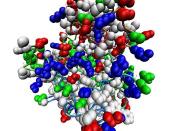Achondroplasia is the most common form of dwarfism found in the world today. It has many serious effects, and can be life threatening, or debilitating in some cases. If the proper precautions are taken, then affected people can usually live fairly normal lives.
Achondroplasia affects about 1 out of every 15,000 people born. It is autosomal dominant, and is caused by an abnormal gene located on chromosome #4. If one parent has the condition and the other does not, with each pregnancy there is a 50 percent chance that each child will be affected. If both parents have Achondroplasia, there is a 50 percent chance that the child will inherit the condition, a 25 percent chance that the child will not have it, and a 25 percent chance that the child will receive one affected gene from each parent and be either stillborn, or die soon after birth. In most cases (over 80 percent), however, Achondroplasia is not inherited but results from a new mutation (change) that occurred in the egg or sperm cell that formed the embryo.
In 1994, researchers identified the gene that causes Achondroplasia. This discovery allowed the development of highly accurate prenatal tests that can diagnose or rule out Achondroplasia. These tests are offered when both expectant parents have Achondroplasia.
The characteristics of Achondroplasia are apparent at birth. The disorder causes several typical facial features such as having a large head with a prominent forehead. The mid face is often small with a flat nose and narrow nasal passages. The jaw tends to be small which can set the stage for dental crowding. Ear infections are common, and if left untreated, can cause hearing damage, or loss. To prevent this, 'ear tubes' are appointed to those that are commonly affected.
Respiratory problems...


